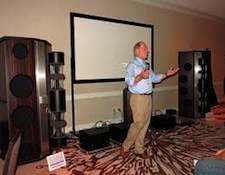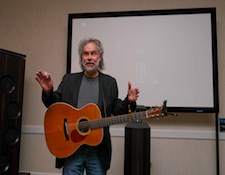It’s the time of year for saving money!
Mark Waldrep’s AIX Records put one of the more interesting demonstrations at this year’s AXPONA in Chicago. Billed as “”IS IT JOHN GORKA OR IS IT HD-AUDIO?” the demo consisted of listening to John Gorka playing live and then listening to AIX’s recordings of John done a couple of years ago. According to Mark Walderp’s pre-demo press release, “Attendees will be able to enjoy songs from my favorite singer songwriter, John Gorka, performed acoustically in the Madison Ballroom and then experience our AIX Records Real HD-Audio recording of John and his band through German Physik’s flagship Emperor speakers powered by Danish high-end maker Vitus Audio in an unprecedented fully immersive 5.1 surround configuration.”
 I arrived early for the demonstration since I was under the impression that getting a good seat might be difficult. When I arrived there were very few people in the room and I was able to command a seat in the front row center, only about four feet away from where Gorka would be performing live. I should mention that I, too, am a big John Gorka fan, and I’ve got all his albums, including the 2007 AIX 5.1 live to digital recording.
I arrived early for the demonstration since I was under the impression that getting a good seat might be difficult. When I arrived there were very few people in the room and I was able to command a seat in the front row center, only about four feet away from where Gorka would be performing live. I should mention that I, too, am a big John Gorka fan, and I’ve got all his albums, including the 2007 AIX 5.1 live to digital recording.
After some words from Mark, Waldrep as well as from German Physics’ Robert Kelly, John Gorka sat down and performed several songs. Sitting only four feet away I was immediately sucked in by the immediacy of his performance and by how quiet one voice accompanied by a fingerpicked guitar can be.
 Once Gorka had performed several songs Mark Waldrep switched over to the 5.1 system and played several selections from his AIX Blu-Ray release. Did the recording sound similar to hearing John Gorka playing only four feet away? Nope, not even close.
Once Gorka had performed several songs Mark Waldrep switched over to the 5.1 system and played several selections from his AIX Blu-Ray release. Did the recording sound similar to hearing John Gorka playing only four feet away? Nope, not even close.
But the reason that the recording of John Gorka didn’t sound exactly like his live performance wasn’t a result of any mistakes on the part of the recording engineer. No, the reason that John Gorka live sounded differently from the recording can be attributed to one primary reason – the proximity effect. According to Wikipedia – “Proximity effect is a change in the frequency response of a microphone, having a directional pickup pattern, that produces an emphasis on lower frequencies. It is caused by the use of ports to create directional polar pickup patterns, so omni-directional microphones do not exhibit the effect. Depending on the microphone design, proximity effect may result in a boost of up to 6 dB, depending on the size of the microphone’s diaphragm and the distance of the source. A ready (and common) example of proximity effect can be observed with cardioid dynamic vocal microphones (though it is not limited to this class of microphone) when the vocalist is very close to or even touching the mic with their lips. The effect is heard as a ‘fattening up’ of the voice. Many radio broadcast microphones are large diameter cardioid pickup pattern microphones, and radio announcers are often observed to employ proximity effect, adding a sense of gravitas and depth to the voice. Proximity effect is sometimes referred to as “bass tip-up.”
For most of his recordings Mark Waldrep employs stereo pairs of microphones in fairly close proximity to each performer or instrument. This positioning causes some amount of “proximity effect” which was quite obvious when we compared the sound of Gorka’s voice live with the recordings. On the recordings Gorka’s vocals were much richer with more lower midrange “chestiness.” While Gorka’s live vocals didn’t sound thin, they did sound less enhanced than on the recordings.
 Waldrep made it quite clear at the beginning of the demonstration that the goal of the presentation wasn’t to show that there were no differences between live and his recordings, but to show how his recordings captured the live feeling of the performance, which they most certainly do. For me the takeaway is that microphone placement is critical yet highly subjective, and still very much an art rather than a science.
Waldrep made it quite clear at the beginning of the demonstration that the goal of the presentation wasn’t to show that there were no differences between live and his recordings, but to show how his recordings captured the live feeling of the performance, which they most certainly do. For me the takeaway is that microphone placement is critical yet highly subjective, and still very much an art rather than a science.
The most variable and still most important aspect of a recording is the engineers’ and producers’ aural concept of how they feel a recording SHOULD sound. Even before applying EQ, compression, limiting, reverb, and other patches to the sound, the placement of microphones is the critical first step of recording that can and will affect everything that comes afterwards.
My primary complaint with the AIX demonstration at AXPONA was that more people didn’t attend it. It reinforced some of my preconceptions about recording while making me aware of how much of what we call recording science is still a matter of capturing an ideal in the engineer and performers’ heads rather than documenting reality. And just as there’s always more than one way to cook and egg, there’s always more than one way to make a recording.





